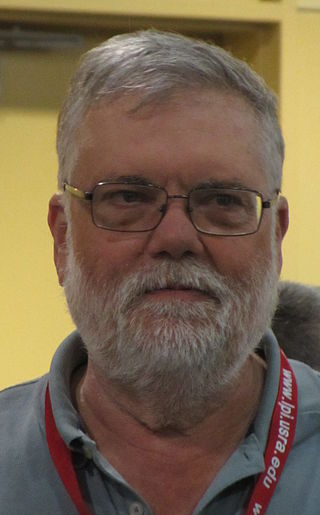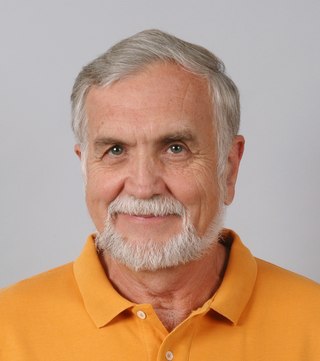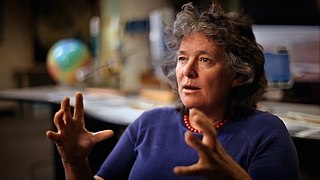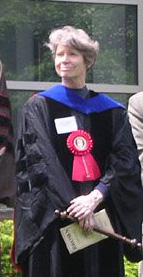Karen J. Meech is an American planetary astronomer at the Institute for Astronomy (IfA) of the University of Hawaiʻi.

Harold (Hal) Masursky was an American astrogeologist.

Planetary geology, alternatively known as astrogeology or exogeology, is a planetary science discipline concerned with the geology of celestial bodies such as planets and their moons, asteroids, comets, and meteorites. Although the geo- prefix typically indicates topics of or relating to Earth, planetary geology is named as such for historical and convenience reasons; due to the types of investigations involved, it is closely linked with Earth-based geology. These investigations are centered around the composition, structure, processes, and history of a celestial body.
George Wetherill was a physicist and geologist and the director emeritus of the department of terrestrial magnetism at the Carnegie Institution of Washington, DC, US.

H. Jay Melosh was an American geophysicist specialising in impact cratering. He earned a degree in physics from Princeton University and a doctoral degree in physics and geology from Caltech in 1972. His PhD thesis concerned quarks. Melosh's research interests include impact craters, planetary tectonics, and the physics of earthquakes and landslides. His recent research includes studies of the giant impact origin of the Moon, the Chicxulub impact that is thought to have extinguished most dinosaurs, and studies of ejection of rocks from their parent bodies. He was active in astrobiological studies that relate chiefly to the exchange of microorganisms between the terrestrial planets.
Bruce William Hapke is a noted American planetary scientist, currently a professor emeritus at the University of Pittsburgh and a specialist in bidirectional reflectance spectroscopy.

Maria T. Zuber is an American geophysicist who is the vice president for research at the Massachusetts Institute of Technology, where she also holds the position of the E. A. Griswold Professor of Geophysics in the Department of Earth, Atmospheric and Planetary Sciences. Zuber has been involved in more than half a dozen NASA planetary missions aimed at mapping the Moon, Mars, Mercury, and several asteroids. She was the principal investigator for the Gravity Recovery and Interior Laboratory (GRAIL) Mission, which was managed by NASA's Jet Propulsion Laboratory.

James F. Bell III is a professor of Astronomy at Arizona State University, specializing in the study of planetary geology, geochemistry and mineralogy using data obtained from telescopes and from various spacecraft missions. Bell's active research has involved the NASA Mars Pathfinder, Near Earth Asteroid Rendezvous (NEAR), Comet Nucleus Tour (CONTOUR), 2001 Mars Odyssey, Mars Reconnaissance Orbiter, Lunar Reconnaissance Orbiter, and the Mars Science Laboratory missions. His book Postcards from Mars includes many images taken by the Mars rovers. Bell is currently an editor of the space science journal Icarus and president of The Planetary Society. He has served as the lead scientist in charge of the Panoramic camera (Pancam) color imaging system on Mars rovers Spirit and Opportunity.
Scott Duncan Tremaine is a Canadian-born astrophysicist. He is a fellow of the Royal Society of London, the Royal Society of Canada and the National Academy of Sciences. Tremaine is widely regarded as one of the world's leading astrophysicists for his contributions to the theory of Solar System and galactic dynamics. Tremaine is the namesake of asteroid 3806 Tremaine. He is credited with coining the name "Kuiper belt".

David Morrison is an American astronomer, a senior scientist at the Solar System Exploration Research Virtual Institute, at NASA Ames Research Center in Mountain View, California. Morrison is the former director of the Carl Sagan Center for Study of Life in the Universe at the SETI Institute and of the NASA Lunar Science Institute. He is the past Director of Space at NASA Ames. Morrison is credited as a founder of the multi-disciplinary field of astrobiology. Morrison is best known for his work in risk assessment of near Earth objects such as asteroids and comets. Asteroid 2410 Morrison was named in his honor. Morrison is also known for his "Ask an Astrobiologist" series on NASA's website where he provides answers to questions submitted by the public. He has published 12 books and over 150 papers primarily on planetary science, astrobiology and near Earth objects.

Ronald Greeley was a Regents’ Professor in the School of Earth and Space Exploration (SESE) at Arizona State University (ASU), the Director of the NASA-ASU Regional Planetary Image Facility (RPIF), and Principal Investigator of the Planetary Aeolian Laboratory at NASA-Ames Research Center. He was involved with lunar and planetary studies since 1967 and most recently focused his research on understanding planetary surface processes and geologic histories.

Ursula Bailey Marvin was an American planetary geologist and author who worked for the Smithsonian Astrophysical Observatory.

Margaret Galland Kivelson is an American space physicist, planetary scientist, and distinguished professor emerita of space physics at the University of California, Los Angeles. From 2010 to the present, concurrent with her appointment at UCLA, Kivelson has been a research scientist and scholar at the University of Michigan. Her primary research interests include the magnetospheres of Earth, Jupiter, and Saturn.

Frances "Fran" Bagenal is a Professor Emerita of Astrophysical and Planetary Sciences at the University of Colorado Boulder and a Senior Research Scientist at the Laboratory for Atmospheric and Space Physics in the fields of space plasmas and planetary magnetospheres.
Bonnie J. Buratti is an American planetary scientist in the Division of Earth and Space Sciences at the Jet Propulsion Laboratory in Pasadena, California, where she leads the Comets, Asteroids, and Satellites Group. Her research involves the composition and physical properties of planetary surfaces, and volatile transport in the outer solar system.

Christina "Chrissy" Richey is an American planetary scientist and astrophysicist working at Jet Propulsion Laboratory in La Cañada Flintridge, California. Richey is a project staff scientist for the Europa Clipper mission and is a research technologist in the Astrophysics and Space Sciences Section. Prior to working at JPL, Richey worked as contractor for Arctic Slope Regional Corporation at NASA Headquarters in Washington, D.C. They were a program officer in NASA's Planetary Science Division, the deputy program scientist for the OSIRIS-REx mission, and the deputy science advisor for research and analysis for the Science Mission Directorate.

Faith Vilas is an American planetary scientist and Director of the MMT Observatory in Arizona.

Lynnae C. Quick is an American planetary geophysicist and Ocean Worlds Planetary Scientist at NASA Goddard Space Flight Center. Her research centers on theoretical modeling of cryovolcanic processes on the icy moons and dwarf planets in the Solar System as well as modeling volcanic activity on Venus and the Moon. Quick is a member of the Dawn, Europa Clipper, and Dragonfly Mission science teams. She is also a member of the NASA Solar System Exploration Research Virtual Institute (SSERVI) Toolbox for Research and Exploration (TREX) team, and serves as co-chair of the Earth and Planetary Systems Sciences section of the National Society of Black Physicists.

John F. Mustard is a planetary scientist and professor of Earth, Environmental, and Planetary Sciences at Brown University. He specializes in using remote sensing and spectroscopy technology to examine and analyze planetary bodies. Mustard investigates the formation and evolution of rocky planets such as Mars, Mercury, the Moon and the Earth.
Nicolas Dauphas is a planetary scientist and isotope geochemist. He is a professor of geochemistry and cosmochemistry in the Department of the Geophysical Sciences and Enrico Fermi Institute at the University of Chicago. Within cosmochemistry, his research focus is on isotope geochemistry. He studies the origin and evolution of planets and other objects in the solar system by analyzing the natural distributions of elements and their isotopes using mass spectrometers.














